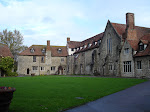
Pilgrims began to make pilgrimage to Canterbury within days of the murder of the Lord Archbishop Thomas Becket in Canterbury Cathedral in December 1170. Accounts of miraculous cures began just two days after the murder.
Henry II (the King on whose behalf Becket was murdered) himself made pilgrimage to Canterbury. Returning from Normandy to Southampton, he rode the Pilgrim's road from Winchester, the ancient capital of England. At Harbledown, just outside of Canterbury, where the Winchester road joined the London road, he made a gift to the Harbledown Almshouses, which was still paid by the Crown even into the twentieth century. Once in sight of the Cathedral Henry dismounted, put on a hair shirt, and walked barefoot in the rain to the Cathedral.
There are two principal pilgrim routes to Canterbury. The first from London is along the Roman Watling Street, now the A2. The other is from Winchester, then Farnham, closely following an ancient trading route, what is now called the North Downs Way. This was the route taken by King Henry II.
The London route take the way of Thomas Becket's last journey. After a sermon to the Augustinian foundation at St Mary's Priory at Southwark (Now Southwark Cathedral) on 23 December 1170, he left for Canterbury along Watling Street. He was murdered in the Cathedral of Canterbury on 29 December 1170.


No comments:
Post a Comment